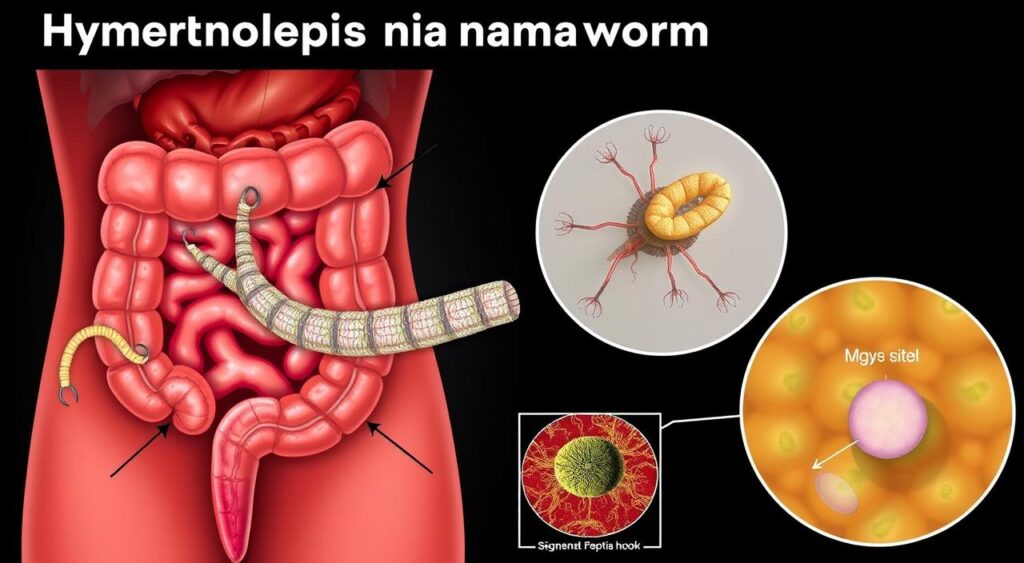Discover the causes, symptoms, and effective remedies for Hymenolepiasis, a parasitic infection.
Every year, 50 million people worldwide suffer from hymenolepiasis. This parasitic disease is caused by the dwarf tapeworm. It’s a big problem for public health. It spreads when people eat or drink contaminated food or water.

Hymenolepiasis can cause mild to severe symptoms. It’s important to know the signs to get help fast. In this guide, we’ll explore hymenolepiasis. We’ll look at its causes, symptoms, and how to treat it.
Key Takeaways
- Hymenolepiasis is a parasitic disease caused by the dwarf tapeworm.
- The disease is typically spread through contaminated food or water.
- Understanding the causes and symptoms of hymenolepiasis is crucial for prevention and treatment.
- Hymenolepiasis can range from mild to severe symptoms.
- Recognizing the signs and symptoms is essential to seek medical attention promptly.
- Effective remedies are available to treat hymenolepiasis.
- Prevention and public health measures can help reduce the risk of tapeworm infection.
Understanding Hymenolepiasis: An Overview
Hymenolepiasis is a disease that affects the intestines. It is caused by tapeworms, like the dwarf tapeworm. Knowing about Hymenolepiasis means understanding its definition, the types of tapeworms involved, and how common it is worldwide.
The dwarf tapeworm is a major health concern. It can lead to malnutrition and weight loss if not treated. Helminth infection is serious and can cause many health problems.
What is Hymenolepiasis?
Hymenolepiasis is a parasitic infection caused by the dwarf tapeworm. It spreads through contaminated food or water. Symptoms include abdominal pain, diarrhea, and weight loss.
Types of Tapeworms Involved
Several tapeworms can cause Hymenolepiasis, like Hymenolepis nana and Hymenolepis diminuta. These tapeworms can infect humans through contaminated food, water, or direct contact with an infected person.
Global Prevalence and Risk Factors
Hymenolepiasis is common worldwide. Poor sanitation, inadequate hygiene, and contaminated food or water are risk factors. Knowing these helps prevent and control the disease.
| Region | Prevalence of Hymenolepiasis |
|---|---|
| Asia | High |
| Africa | Moderate |
| Latin America | Low |
Knowing the global prevalence and risk factors helps us fight Hymenolepiasis. We can prevent and control the dwarf tapeworm infection.
The Life Cycle of Dwarf Tapeworms
The life cycle of dwarf tapeworms is quite complex. It involves several stages that lead to intestinal infection. These tapeworms are usually eaten through contaminated food or water. Once inside, they stick to the intestinal wall and start feeding on nutrients.
This feeding process causes a variety of symptoms. Some important facts about dwarf tapeworms include:
- They can be ingested through contaminated food or water
- They attach themselves to the intestinal wall
- They feed on nutrients in the intestines, causing intestinal infection
Knowing how dwarf tapeworms live is key to stopping intestinal infection. By understanding the risks and taking steps to prevent it, we can lower our chances of getting infected. This helps keep us healthy and well.
| Stage | Description |
|---|---|
| Ingestion | Tapeworms are ingested through contaminated food or water |
| Attachment | Tapeworms attach themselves to the intestinal wall |
| Feeding | Tapeworms feed on nutrients in the intestines, causing intestinal infection |
Common Transmission Routes and Risk Factors
Enterobiasis is a parasitic infection that can spread hymenolepiasis. Knowing how it spreads and who’s at risk is key to stopping it. Parasitology helps us understand the causes and effects of hymenolepiasis.
Hymenolepiasis can spread in several ways:
- Direct person-to-person transmission: This happens when people share food or utensils with someone who’s infected.
- Environmental contamination: The parasite can live in soil, water, or on surfaces, making infection more likely.
- Food-related transmission: Eating food or drinking water that’s contaminated with the parasite can cause infection.
Parasitology research shows that enterobiasis can help spread hymenolepiasis. Knowing how it spreads helps us prevent it.
It’s important to remember that enterobiasis can make it easier for hymenolepiasis to spread. By studying parasitology, we can find ways to stop hymenolepiasis from spreading.
| Transmission Route | Risk Factor |
|---|---|
| Direct person-to-person transmission | Close contact with an infected person |
| Environmental contamination | Contaminated soil, water, or surfaces |
| Food-related transmission | Consuming contaminated food or water |
Recognizing the Signs and Symptoms
The signs of Hymenolepiasis can differ from person to person. Common symptoms include abdominal pain, diarrhea, and weight loss. It’s important to spot these signs early to get the right treatment. This is key for keeping public health safe.
If Hymenolepiasis goes untreated, it can cause serious problems. These issues can harm not just the person but also the whole community.
For public health, knowing the symptoms of Hymenolepiasis is crucial. This knowledge helps stop the disease from spreading. Education and awareness are key. They help people recognize symptoms and get help fast.
Some common symptoms are:
- Abdominal pain
- Diarrhea
- Weight loss
- Fatigue
- Nausea and vomiting
By knowing the signs of Hymenolepiasis, we can all help keep public health safe. We should practice good hygiene, like washing our hands often. And if symptoms don’t go away, we should see a doctor.
Diagnosis Methods and Testing Procedures
To diagnose Hymenolepiasis, doctors use stool tests and advanced methods. They look for tapeworm eggs or segments in a stool sample. Treatment options are then available.
Some common ways to diagnose include:
- Stool examination techniques, such as direct microscopy or concentration methods
- Advanced diagnostic methods, such as PCR (polymerase chain reaction) or serology tests
- Differential diagnosis considerations, to rule out other possible causes of symptoms
It’s crucial to think about treatment options when diagnosing Hymenolepiasis. Quick and effective treatment can prevent complications and improve health.
Understanding different diagnosis methods helps doctors give accurate diagnoses. They can then find the best treatment options for patients with Hymenolepiasis.
Treatment Options and Medical Interventions
The treatment for hymenolepiasis usually involves anthelmintic medications. These drugs are made to kill tapeworms. The main goal is to get rid of the tapeworm infection and stop any further problems.
There are a few ways to treat hymenolepiasis:
- Anthelmintic medications, such as praziquantel or niclosamide
- Supportive care, like rest and drinking water, to help with symptoms
- Dietary changes, like avoiding raw meat and veggies, to stop getting infected again
In serious cases of hymenolepiasis, you might need to stay in the hospital. This is to handle any big problems and give you the care you need. If your symptoms don’t get better or get worse, you should see a doctor right away.

Knowing about the treatments and medical help for hymenolepiasis can help you manage your condition. It also helps prevent more problems from the tapeworm infection.
| Treatment Option | Description |
|---|---|
| Anthelmintic medications | Medications designed to kill tapeworms |
| Supportive care | Rest, hydration, and dietary changes to manage symptoms |
Prevention Strategies and Public Health Measures
To stop hymenolepiasis, we need to work together. This means good personal hygiene, clean environments, and community health efforts. Knowing how it spreads and acting early can help a lot.
Keeping clean is key to stopping hymenolepiasis. Regular handwashing with soap and water is important. Also, make sure to avoid eating food or drinking water that might be contaminated.
Key Prevention Strategies
- Practice good hygiene, including regular handwashing and proper disposal of human waste
- Avoid eating undercooked or raw meat, especially pork and beef
- Use clean water for drinking and cooking
- Avoid close contact with individuals who have a helminth infection
Community health programs are also very important. They help spread the word, improve sanitation, and make sure everyone has access to clean water and healthcare. Together, we can fight this disease and make our communities healthier.
By using these prevention methods, we can keep ourselves and our communities safe from hymenolepiasis and other helminth infections.
| Prevention Strategy | Description |
|---|---|
| Personal Hygiene | Regular handwashing, proper disposal of human waste |
| Environmental Sanitation | Access to clean water, proper waste management |
| Community Health Programs | Public awareness campaigns, sanitation initiatives, access to healthcare services |
Living with and Managing Hymenolepiasis
Managing hymenolepiasis needs a long-term effort in treatment and prevention. It can be controlled by sticking to a treatment plan and keeping good hygiene. Personal hygiene practices are key in stopping the disease from spreading. This means washing hands often, especially after using the bathroom and before meals.
Dealing with hymenolepiasis can be tough, but it’s doable with the right approach. The dwarf tapeworm is a common cause of intestinal infections. Knowing how it spreads and lives is key to avoiding it. Here are some ways to manage hymenolepiasis:
- Practicing good hygiene
- Following a treatment plan
- Avoiding contaminated food and water
By following these tips and understanding hymenolepiasis, people can manage the disease well.

It’s important to remember that hymenolepiasis is treatable. With the right care and prevention, people can live healthy lives. Being aware of the risks and taking steps to prevent it can lower the chance of getting infected with the dwarf tapeworm and intestinal infections.
Conclusion
Hymenolepiasis is a big public health issue that needs our attention. We must know how it spreads and how to treat it. This helps us fight this parasitic infection better.
Using strong tests and treatments is key. So is stopping it before it starts. This way, we can tackle hymenolepiasis more effectively.
We need to boost public health efforts and research in parasitology. It’s also important to have good treatment options for enterobiasis. Everyone must work together to stop this disease.
Healthcare workers, leaders, and communities should all help. We need to spread the word, keep clean, and improve where we live. This will help fight hymenolepiasis.
By focusing on hymenolepiasis, we can help people and communities. We can make life better for those affected. And we can help everyone stay healthy.
FAQ
Q: What is Hymenolepiasis?
A: Hymenolepiasis is a parasitic infection caused by the dwarf tapeworm, Hymenolepis nana. It affects the intestines.
Q: What are the symptoms of Hymenolepiasis?
A: Symptoms include abdominal pain, diarrhea, weight loss, and nausea. Sometimes, there are no symptoms at all.
Q: How is Hymenolepiasis transmitted?
A: It spreads through contaminated food or water, or direct contact. Poor hygiene and environmental contamination also play a role.
Q: How is Hymenolepiasis diagnosed?
A: Diagnosis involves stool tests for tapeworm eggs or segments. Serological tests may also be used.
Q: What are the treatment options for Hymenolepiasis?
A: Treatment includes anthelmintic medications to kill tapeworms. The plan depends on the infection’s severity and the patient’s health.
Q: How can Hymenolepiasis be prevented?
A: Prevention involves good hygiene, environmental sanitation, and community health programs. Avoiding contaminated food and water is key.
Q: What are the long-term effects of Hymenolepiasis?
A: Untreated Hymenolepiasis can cause intestinal blockages, malnutrition, and developmental issues in children. Early treatment is crucial to avoid these effects.
